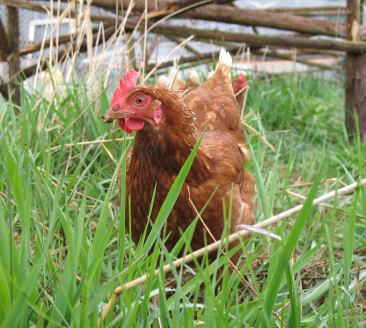 Ecomomic splendor in the grass. I just completed a profile of one of the most exciting food production ideas I have seen in a long time. Hillside Farmers Co-op. in Northfield, Minnesota, initiated by Latino immigrants, raises free-range chickens on scattered small, one-quarter acre sites. This makes it a great model for urban farmers as well as rural.
Ecomomic splendor in the grass. I just completed a profile of one of the most exciting food production ideas I have seen in a long time. Hillside Farmers Co-op. in Northfield, Minnesota, initiated by Latino immigrants, raises free-range chickens on scattered small, one-quarter acre sites. This makes it a great model for urban farmers as well as rural.
By staying small, co-op leader, Regi Haslett-Marroquin told me, Latino farmers will be able to start a farm even though they have very little capital to work with. In just a few weeks, each farm can sell about a thousand chickens. That quick turnaround will be key to building savings. Over time, it will allow farmers to make more expansive choices in the future, he says – perhaps to buy their own land, or to start supportive businesses in the region. By keeping each production unit small and family-sized, Marroquin believes, farmers can have a great deal of independence, and the network of small producers can more easily respond to changing market conditions.
Start-up costs are relatively small. The Co-op has designed simple chicken barns, framed from wood and covered with plastic sheets, that provide shelter for the birds from spring through fall. Each barn has large doors through which young chicks can stroll at will – and do so, because their feed is outside.
Hillside Co-op’s chickens “work out” every day (they are not raised in winter). Running through fields, pulling sprouted barley grass out of the ground, and searching out organic grains to eat from scattered feeding stations, the chicks build muscle tone. This is a marked contrast to industrial farms in which so-called “free-range” chickens are raised. In those confined operations, there may be a small door for chickens to use to walk outside, but few of the birds even realize they have that choice.
Marroquin promises that production practices will be highly sustainable. He says Co-op farmers will rotate grains, grasses, and perennial crops in their fields, building new organic matter in the soil. This rotation will also help the birds to be healthy. Feed selections ensure that the meat from these chickens is high in omega-3 oils.
In order to efficiently process these chickens for consumers, Co-op leaders hope to run a large processing plant someday. Yet that must wait until the producers reach enough volume to use processing lines well. Finished birds will be distributed through an existing business, Thousand Hills Cattle Company, of Cannon Falls.
The Co-op’s success, Marroquin adds, will depend on its ability to organize elements of the mainstream economy to create an unconventional outcome – ownership for Latinos. By carefully networking with local business leaders and economic developers, Marroquin has scored generous donations of land and equipment to help the Co-op get underway, despite its limited resources.
Marroquin recently made a big splash when he presented his vision for the Co-op in a plenary speech at the Community Food Security Conference annual meeting in Des Moines in October. He will be featured again at the Home Grown Economy forum, sponsored by Rep. Collin Peterson, the chair of the U.S. House Agriculture Committee, on February 16, 2010, in Marshall, Minnesota.
You can read the full story, and view photos, at the Edible Twin Cities website.
I welcome your comments!



